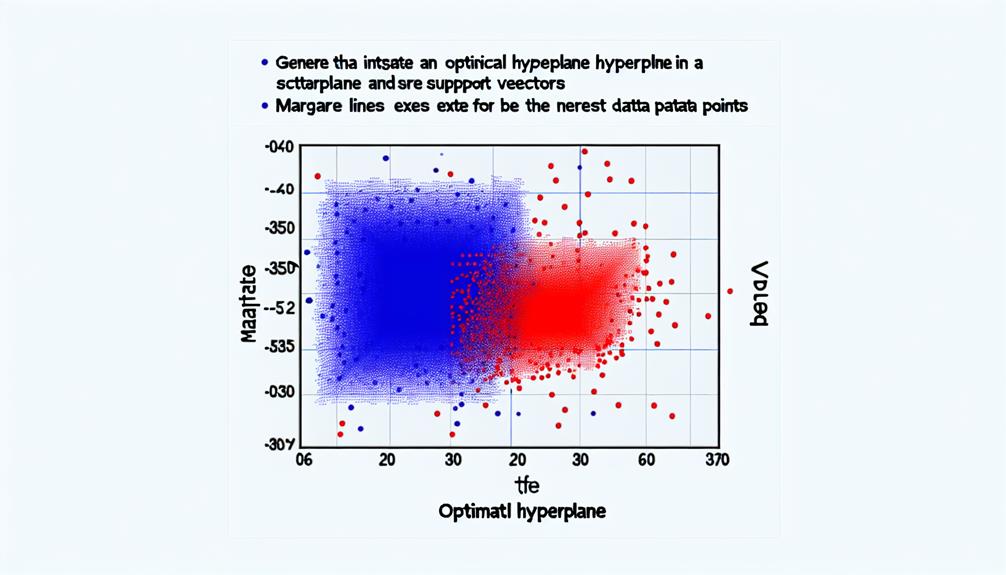The top 5 machine learning algorithms for data analysis include linear regression for understanding relationships and predictive modeling, logistic regression for binary classification, decision trees and random forests for mitigating overfitting and improving accuracy, naive Bayes for text classification and high-dimensional data, and support vector machines for identifying best-fit hyperplanes in linear and non-linear classification tasks. These foundational algorithms are essential for discovering patterns and making predictions in diverse applications. Pursuing further exploration will uncover the nuances and applications of these machine learning tools.
Key Takeaways
- Linear regression establishes a relationship between independent and dependent variables for predictive modeling.
- Logistic regression predicts binary outcomes using the sigmoid function in applications like disease prediction and customer churn analysis.
- Decision trees and random forests predict based on rule-based systems, addressing overfitting and improving accuracy.
- Naive Bayes leverages Bayes' theorem for class probabilities, particularly effective in text classification tasks handling high-dimensional data.
- Support vector machines (SVMs) use kernel functions to identify the best hyperplane for class separation in linear and non-linear classification tasks.
Linear Regression and Line Fitting
Linear regression is a fundamental technique in machine learning that enables the analysis of relationships between dependent and independent variables, providing a foundational basis for predictive modeling and trend identification. This statistical method aims to find the best-fitting line (or hyperplane) that minimizes the sum of the squared differences between the actual and predicted values.
In linear regression, the equation for the simple regression model is y = mx + b, where y is the dependent variable, x is the independent variable, m is the slope, and b is the intercept. The regression line is determined by optimizing parameters to reduce the error between predicted and actual values, allowing for predictive analysis and trend identification.
One of the key applications of linear regression is its line fitting capabilities, which facilitate the visualization and understanding of the relationship between the independent variables and the dependent variable. By using linear regression models, data analysts can uncover intrinsic patterns and make informed decisions about future trends.
Logistic Regression for Classification
Logistic regression, a widely employed machine learning algorithm, excels in binary classification tasks by utilizing the logistic function to output probabilities between 0 and 1, making it a fundamental tool in predictive modeling.
This supervised learning algorithm is particularly effective in classifying binary data, such as determining whether an email is spam or not. In the field of healthcare, logistic regression is used to predict the likelihood of a disease or medical event. It is also applied in customer churn analysis to identify the probability of a customer leaving a service.
Logistic regression models the probability of a binary outcome by mapping the linear output of a model to a probability that falls between 0 and 1. This is achieved through the sigmoid function, which transforms the linear combination of inputs into a probability.
The algorithm's outputs allow for clear classification and prediction, making it valuable in data analysis. Moreover, logistic regression is fast to train and provides valuable insights into the impact of each feature on the classification outcome.
Its simplicity, interpretability, and effectiveness make it a fundamental tool in machine learning for binary classification problems.
Decision Trees and Random Forests

While logistic regression provides valuable insights into binary classification problems, decision trees and random forests offer robust models for both classification and regression tasks.
Decision trees, as tree-like structures, employ a sequence of rules to make predictions based on features in the data. However, their tendency to overfit can lead to inaccurate outcomes.
Random forests, an ensemble model created from multiple decision trees, address the overfitting issue by aggregating predictions from various trees. This ensemble approach improves the model's accuracy and generalization capabilities.
Naive Bayes for Probability Assessment
Naive Bayes is a probabilistic algorithm that leverages Bayes' theorem to calculate class probabilities based on feature independence assumptions, demonstrating robust performance in text classification tasks such as spam filtering and sentiment analysis.
This algorithm's efficacy in handling high-dimensional data is particularly remarkable, allowing it to quickly learn from limited training data. The simplicity and efficiency of Naive Bayes make it an attractive choice for dealing with large datasets.
Despite its seemingly naive assumption of feature independence, Naive Bayes often delivers surprisingly strong results, especially in contexts where other machine learning techniques might struggle. This is because Naive Bayes classifiers work by predicting the class with the highest probability for a given set of features, which proves effective in many applications.
Its high speed during both training and prediction adds to its practical value, making it a reliable choice for data analysts.
Support Vector Machines for Hyperplanes

Support Vector Machines are a family of supervised learning algorithms that excel in identifying the best hyperplane, which maximally separates classes in high-dimensional spaces, making them a versatile tool for classification tasks. By maximizing the margin between classes, SVM ensures superior generalization and classification performance. SVM is particularly effective for both linear and non-linear classification tasks due to its ability to utilize kernel functions, which transform complex data into linearly separable formats.
| Algorithm Capability | Description |
|---|---|
| Hyperplane Identification | Find the best hyperplane that maximizes the |
| margin between classes. | |
| Margin Maximization | Enhance the margin to improve generalization and |
| classification performance. | |
| Kernel Utilization | Use kernel functions to handle linear and non |
| linear classification tasks. | |
| High-Dimensional Handling | Efficiently manage data with a large number of |
| features. | |
| Classification Performance | Robust performance in image recognition, text |
| classification, and bioinformatics. |
SVM's versatility and robustness make it a widely adopted algorithm in various data analysis applications.
Frequently Asked Questions
What Are the Five Popular Algorithms of Machine Learning?
The five popular algorithms of machine learning are Logistic Regression for binary classification, Decision Trees for rearranged classification-routing, Support Vector Machines for hyperplane-based classification, K-Means Clustering for grouping similar instances, and Naive Bayes for probabilistic classification.
What Are Machine Learning Algorithms in Data Analysis?
Machine learning algorithms in data analysis help computers learn from data and make predictions. They include models like regression analysis, clustering techniques, decision trees, support vector machines, and ensemble methods for insightful data interpretation.
What Are the Four 4 Types of Machine Learning Algorithms?
In machine learning, the four main types of algorithms are supervised learning, unsupervised learning, semi-supervised learning, and reinforcement learning. These divisions guide the implementation of classification, regression, clustering, dimensionality reduction, anomaly detection, and ensemble methods.
What Is the Best Machine Learning Algorithm?
The best machine learning algorithm depends on the task and dataset; Decision Trees and Random Forest are versatile for classification and regression, while Logistic Regression excels in binary classification, and Support Vector Machines are effective in high-dimensional spaces.









